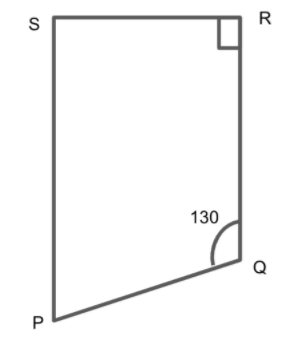
Find the measure of \[\angle {\text{P}}\] and \[\angle {\text{S}}\], if \[\overline {{\text{SP}}} ||\overline {{\text{RQ}}} \] in figure (if you find \[{\text{m}}\angle {\text{R}}\], is there more than one method to find \[{\text{m}}\angle {\text{P}}\]?)


Answer
576.3k+ views
Hint: First we will use the property that the line segment SP is parallel to RQ, the adjacent angles are supplementary, that is, the sum of the angles \[\angle {\text{S}}\] and \[\angle {\text{R}}\] is \[180^\circ \] to find the value of \[\angle {\text{S}}\]. Then we will use the another property that the sum of all four angles of a quadrilateral is 360 degrees and substitute the values of \[\angle {\text{R}}\], \[\angle {\text{S}}\] and \[\angle {\text{Q}}\] in the above equation to find the required value.
Complete step by step solution: We are given that the angle \[\angle {\text{Q}}\] is 130 degrees and angle \[\angle {\text{R}}\] is 90 degrees.
Since we know that the line segment SP is parallel to RQ, the adjacent angles are supplementary, that is, the sum of the angles \[\angle {\text{S}}\] and \[\angle {\text{R}}\] is \[180^\circ \].
Then, we have
\[ \Rightarrow \angle {\text{S}} + \angle {\text{R}} = 180^\circ \]
Substituting the value of \[\angle {\text{R}}\] in the above equation, we get
\[ \Rightarrow \angle {\text{S}} + 90^\circ = 180^\circ \]
Subtracting the above equation by \[90^\circ \] on both sides, we get
\[
\Rightarrow \angle {\text{S}} + 90^\circ - 90^\circ = 180^\circ - 90^\circ \\
\Rightarrow \angle {\text{S}} = 90^\circ \\
\]
We also know that the sum of all four angles of a quadrilateral is 360 degrees, we get
\[ \Rightarrow \angle {\text{S}} + \angle {\text{R}} + \angle {\text{P}} + \angle {\text{Q}} = 360^\circ \]
Substituting the values of \[\angle {\text{R}}\], \[\angle {\text{S}}\] and \[\angle {\text{Q}}\] in the above equation, we get
\[
\Rightarrow 90^\circ + 90^\circ + \angle {\text{P}} + 130^\circ = 360^\circ \\
\Rightarrow \angle {\text{P}} + 310^\circ = 360^\circ \\
\]
Subtracting the above equation by \[310^\circ \] on both sides, we get
\[
\Rightarrow \angle {\text{P}} + 310^\circ - 310^\circ = 360^\circ - 310^\circ \\
\Rightarrow \angle {\text{P}} = 50^\circ \\
\]
Note: In solving these types of questions, you should know that a trapezium is a type of quadrilateral, which has only two parallel sides and the other two sides are non-parallel.
We can also this problem by another method, as we know that the adjacent interior angles are supplementary, so the sum of angles \[\angle {\text{Q}}\] and \[\angle {\text{P}}\] is equal to \[180^\circ \].
Then, we have
\[ \Rightarrow \angle {\text{Q}} + \angle {\text{P = 180}}^\circ \]
Substituting the value of the angle \[\angle {\text{Q}}\] from the diagram in the above equation, we get
\[ \Rightarrow 130^\circ + \angle {\text{P = 180}}^\circ \]
Subtracting the above equation by \[130^\circ \] on both sides, we get
\[
\Rightarrow 130^\circ + \angle {\text{P}} - 130^\circ {\text{ = 180}}^\circ - 130^\circ \\
\Rightarrow \angle {\text{P = 50}}^\circ \\
\]
Complete step by step solution: We are given that the angle \[\angle {\text{Q}}\] is 130 degrees and angle \[\angle {\text{R}}\] is 90 degrees.
Since we know that the line segment SP is parallel to RQ, the adjacent angles are supplementary, that is, the sum of the angles \[\angle {\text{S}}\] and \[\angle {\text{R}}\] is \[180^\circ \].
Then, we have
\[ \Rightarrow \angle {\text{S}} + \angle {\text{R}} = 180^\circ \]
Substituting the value of \[\angle {\text{R}}\] in the above equation, we get
\[ \Rightarrow \angle {\text{S}} + 90^\circ = 180^\circ \]
Subtracting the above equation by \[90^\circ \] on both sides, we get
\[
\Rightarrow \angle {\text{S}} + 90^\circ - 90^\circ = 180^\circ - 90^\circ \\
\Rightarrow \angle {\text{S}} = 90^\circ \\
\]
We also know that the sum of all four angles of a quadrilateral is 360 degrees, we get
\[ \Rightarrow \angle {\text{S}} + \angle {\text{R}} + \angle {\text{P}} + \angle {\text{Q}} = 360^\circ \]
Substituting the values of \[\angle {\text{R}}\], \[\angle {\text{S}}\] and \[\angle {\text{Q}}\] in the above equation, we get
\[
\Rightarrow 90^\circ + 90^\circ + \angle {\text{P}} + 130^\circ = 360^\circ \\
\Rightarrow \angle {\text{P}} + 310^\circ = 360^\circ \\
\]
Subtracting the above equation by \[310^\circ \] on both sides, we get
\[
\Rightarrow \angle {\text{P}} + 310^\circ - 310^\circ = 360^\circ - 310^\circ \\
\Rightarrow \angle {\text{P}} = 50^\circ \\
\]
Note: In solving these types of questions, you should know that a trapezium is a type of quadrilateral, which has only two parallel sides and the other two sides are non-parallel.
We can also this problem by another method, as we know that the adjacent interior angles are supplementary, so the sum of angles \[\angle {\text{Q}}\] and \[\angle {\text{P}}\] is equal to \[180^\circ \].
Then, we have
\[ \Rightarrow \angle {\text{Q}} + \angle {\text{P = 180}}^\circ \]
Substituting the value of the angle \[\angle {\text{Q}}\] from the diagram in the above equation, we get
\[ \Rightarrow 130^\circ + \angle {\text{P = 180}}^\circ \]
Subtracting the above equation by \[130^\circ \] on both sides, we get
\[
\Rightarrow 130^\circ + \angle {\text{P}} - 130^\circ {\text{ = 180}}^\circ - 130^\circ \\
\Rightarrow \angle {\text{P = 50}}^\circ \\
\]
Recently Updated Pages
Master Class 9 Social Science: Engaging Questions & Answers for Success

Master Class 9 Science: Engaging Questions & Answers for Success

Master Class 9 English: Engaging Questions & Answers for Success

Master Class 9 Maths: Engaging Questions & Answers for Success

Master Class 9 General Knowledge: Engaging Questions & Answers for Success

Class 9 Question and Answer - Your Ultimate Solutions Guide

Trending doubts
Which places in India experience sunrise first and class 9 social science CBSE

Fill the blanks with the suitable prepositions 1 The class 9 english CBSE

Write the 6 fundamental rights of India and explain in detail

Difference Between Plant Cell and Animal Cell

What is pollution? How many types of pollution? Define it

What is the Full Form of ISI and RAW





